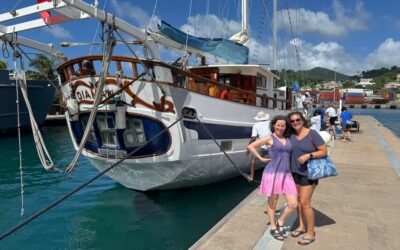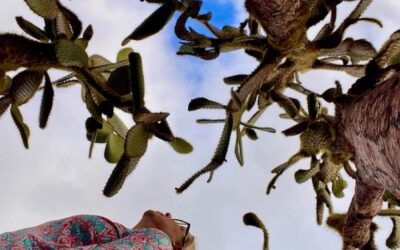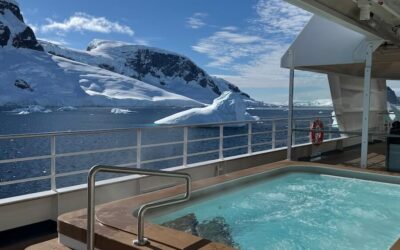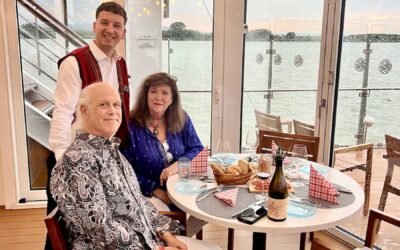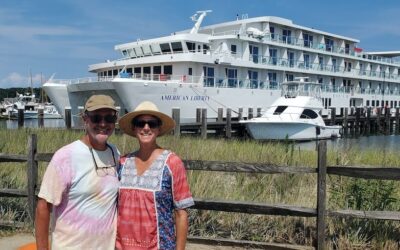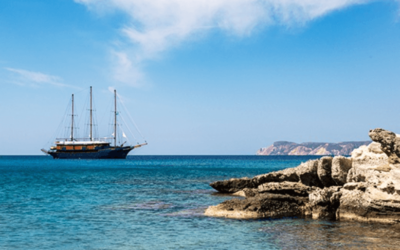By Laurel & Charles Doherty.
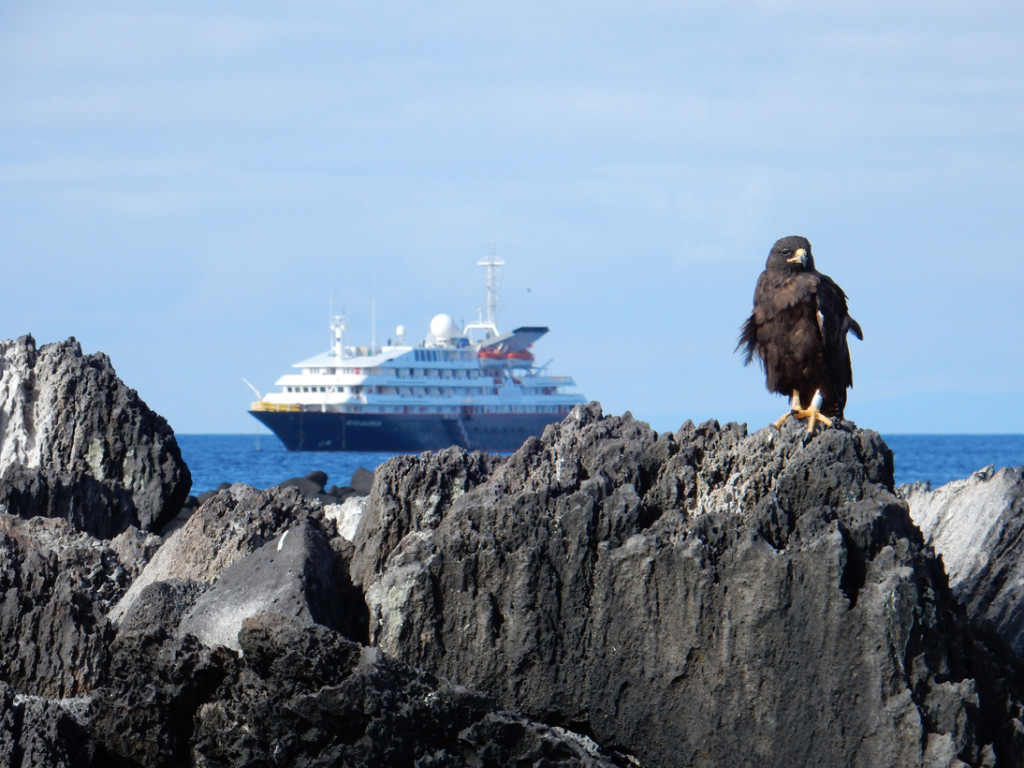
Galapagos hawk, Silver Galapagos cruise ship in background, Isla Espanola. * Photo: Charlie & Laurel Doherty
“Dross, worthless…” was how Fray Tomas De Berlanga, the Bishop Of Panama, found the Galapagos Islands in 1535. “Paradise on earth” was how one Silver Galapagos cruiser, a New England restaurateur, found the archipelago in 2015. Both descriptions are apropos, then and now.
De Berlanga, credited as the islands’ discoverer, was no explorer. Currents carried his sailing ship, becalmed en route from Panama to Peru, west to the Galapagos. There was no freshwater on the first isle landed upon, and two men and 10 horses died of thirst before it was found on the second. On Silversea Expeditions’ cruises of the islands, water bottles are, of course, provided for all Silver Galapagos passengers on every excursion.
The famous archipelago, of volcanic origin, straddles the equator some 600 miles west of mainland South America and comprises 15 larger islands, several smaller ones, and more than a hundred other islets and rocks scattered about. Galapagos is a province of Ecuador, with a population of nearly 27,000 living on the five inhabited islands. In 1959, 97 percent of the area became a national park, which is now within a 52,000-square-mile marine reserve, one of the world’s largest. The three major ocean currents that converge on the Galapagos, along with the air currents, are responsible for carrying a wide range of flora and fauna to the islands. Over the millennia, in their isolation on the remote islands, many of these plants and animals evolved into unique, endemic species found nowhere else in the world.
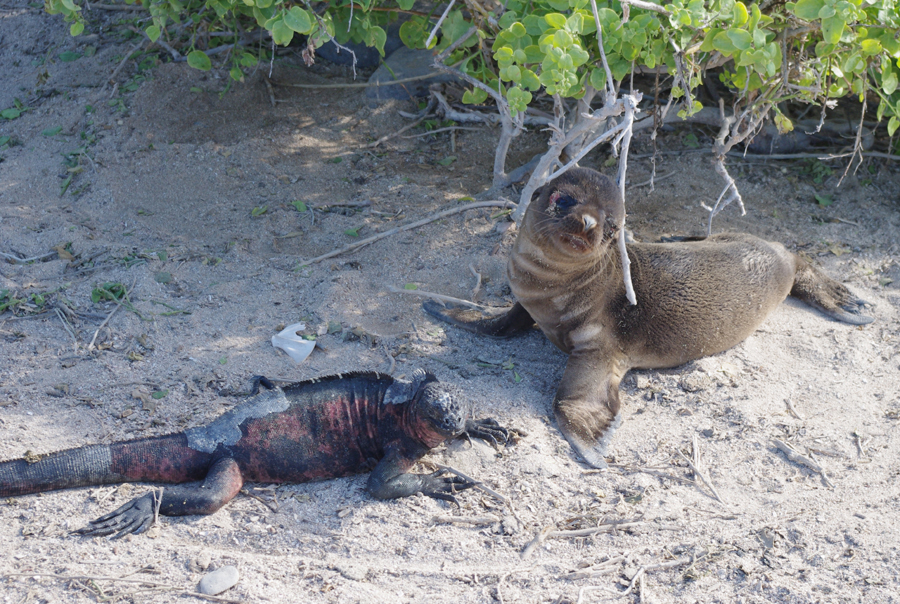
Marine iguana with baby Galapagos sea lion at Punta Pitt, Isla De San Cristobal, Galapagos Islands. * Photo: Charlie & Laurel Doherty
The island chain is named for the saddleback giant tortoises that intrigued De Berlanga and every subsequent visitor (galopego was a popular style of Spanish saddle in the 16th century). Of the 15 giant tortoise species that once called the Galapagos home, regrettably only 11 still exist. These and other endemic species observed by Charles Darwin during his 1835 visit to the islands helped him to develop his theory of natural selection. And this amazing biodiversity is the prime reason the Galapagos Islands are selected as a travel destination by some 400,000 travelers every year.
The best way to see the archipelago is by sea, the choice of nearly half the visitors. About 85 vessels that tour the islands have overnight passenger accommodations, some 20 of which offer cruise-ship-like features; but only one, the Silver Galapagos, has the space, comfort, and style that luxury line Silversea Cruises is known for.
Our introduction to the islands’ wildlife came early. On the tender transfer from the Baltra airport pier, we passed a sea lion and her pup sunning themselves on a buoy, while odd-looking birds went fishing around us—some diving under, others plucking their prey from the surface. Then as we were boarding the ship, we spotted green sea turtles mating in a menage a trois (we later learned that having a backup male is typical).
The 290-foot-long/4,200-gross-ton Silver Galapagos, sparkling from her recent refurbishment, looked like a billionaire’s private yacht. Silversea, which has been setting standards in the luxury cruise market since the line’s debut in 1994, launched its Silversea Expeditions brand in 2008 to offer exploration cruising paired with the comfort of the line’s signature lifestyle. In June 2012, Silversea purchased Canodros S.A., the premier Ecuadorian tourism company, and its 100-passenger Galapagos Explorer II, the largest ship licensed to cruise in the national park. The cruise liner was refurbished and re-entered service in September 2013 as the Silver Galapagos, the second member of the Silversea Expeditions fleet. She was built in 1990 as the Renaissance Three for innovative but now defunct Renaissance Cruises, whose well-constructed vessels have been eagerly snapped up by other lines.
The ship’s basic layout has changed little, but the decor and use of space has changed dramatically. The expansive open decks (which originally included three full-circle promenades) have been rebuilt into private balconies for 22 more suites, an al fresco restaurant, additional outdoor lounge seating, expedition spaces for kayaks and landing craft, and a changing/cleaning/storage area for wetsuits and snorkeling gear. (A full-circuit promenade stroll can still be made.) New on the top deck forward is a large Jacuzzi tub outdoors plus indoor spaces for a well-equipped fitness center and a beauty salon with massage room.
Two decks down, aft, the redecorated Piano Bar is brighter and more open, having lost its small casino and added outdoor seating (the only place onboard where smoking is permitted). A circular staircase leads below to the Explorer Lounge, where the formerly cramped cabaret room has been transformed into a spacious setting for multimedia presentations by the expedition staff and guest experts; new, comfortable seating accommodates all guests, and the room has a pleasing blue and beige color scheme.
This soothing palette extends past the well-stocked Library, through the hallways, and into the suites, which all have elegant new soft furnishings and new bathrooms with marble details. All accommodations are outside, midship-forward on each of the five passenger decks (which are connected by an elevator), and grouped in five categories. The 24 Explorer Suites measure 210 to 250 square feet, and most have picture-windows (seven have portholes). The 22 Terrace/Veranda/Deluxe Veranda Suites range from 268 to 303 square feet, including veranda. Four Silver Suites are 361 square feet, including veranda. Every suite features butler service, mini-fridge stocked with complimentary soft and alcoholic drinks, room service, twin beds convertible to queen-size, sitting area, flat-screen TV with satellite and movie channels, free Wi-Fi (some usage charges may apply), robes and slippers, binoculars, and more. While spacious, comfortable, and amenity-laden, Silver Galapagos suites are not comparable to those of the main Silversea fleet (for instance, none have bathtubs).
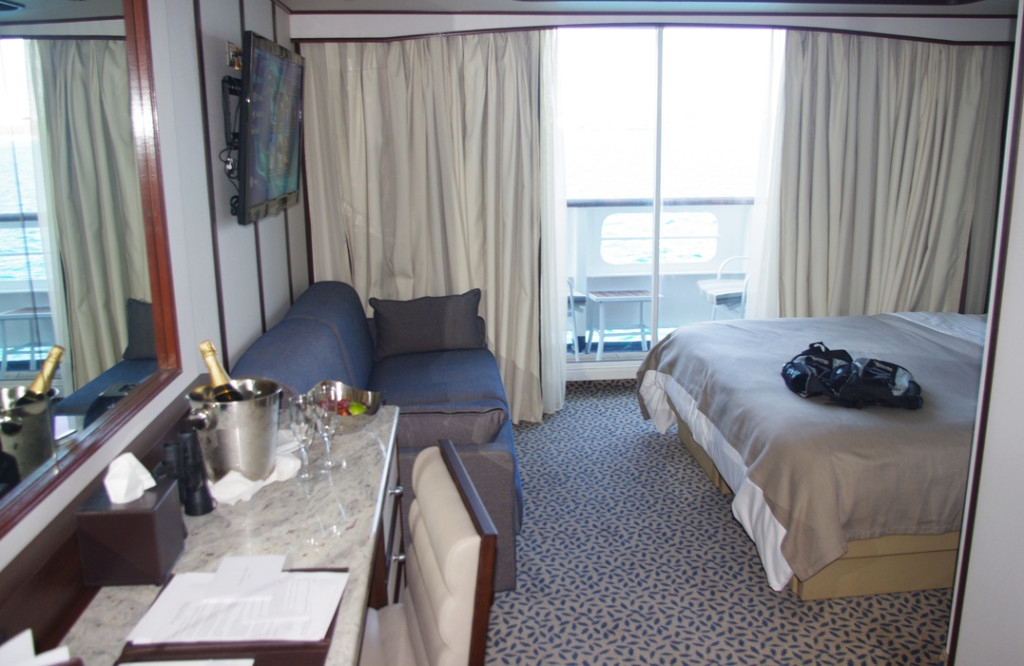
A 268-square-foot Veranda Suite aboard Silversea Cruises’ Silver Galapagos cruise ship. * Photo: Charlie & Laurel Doherty
The cruise liner flies the flag of Ecuador and carries an all-Ecuadorian crew of 75, led by officers with years of experience in Galapagos waters. The hotel staff is friendly, enthusiastic, eager to please, and clearly competent, but does not exhibit the white-glove, European-style finesse typically found on Silversea. The cuisine, Mediterranean-influenced with South American flair, is well prepared, tasty, and beautifully presented, but lacks variety. Ecuadorian regulations, particularly stringent in the fragile Galapagos environment, limit provisioning, especially for meats—though fresh produce arrives onboard three times a week. Similarly, the liquor and beer choices are confined to local labels and familiar premium brands typically imported into Ecuador, so super-premium selections are not available. A wide variety of fine South American wines is served, including excellent vintages from Argentina and Chile. All beverages are complimentary, except for those on a premium wine list with choices from around the world. All gratuities are included in the fares.
But we came to explore the living museum that is the Galapagos Islands, not bask in the lap of luxury, and here the cruise exceeded our expectations. The first evening—amid unpacking, relaxing, and dining—we met our expedition team: seven Galapagos National Park Naturalist Guides and two expert guest guides chosen by Silversea. Every day they’d be leading groups of a dozen or so passengers on a variety of included excursions of varying degrees of difficulty. The rules are strict: stay with the guide, do not stray from the marked trails, keep at least six feet from the animals, no food, no smoking—basically, leave only your footprints behind.
We’d be tendering at every stop in Zodiacs (rigid inflatable landing craft), with many of the landings wet, so we were instructed in the safe way to go over the side into the surf. We were advised to wear sturdy footwear, loose clothing, and sun hats, and bring sunglasses, sunscreen, water, raincoat, and insect repellant. We ended up needing all but the latter, though we used our raincoats only as windbreakers. (Walking sticks were also available, and sometimes we wished we had them.)
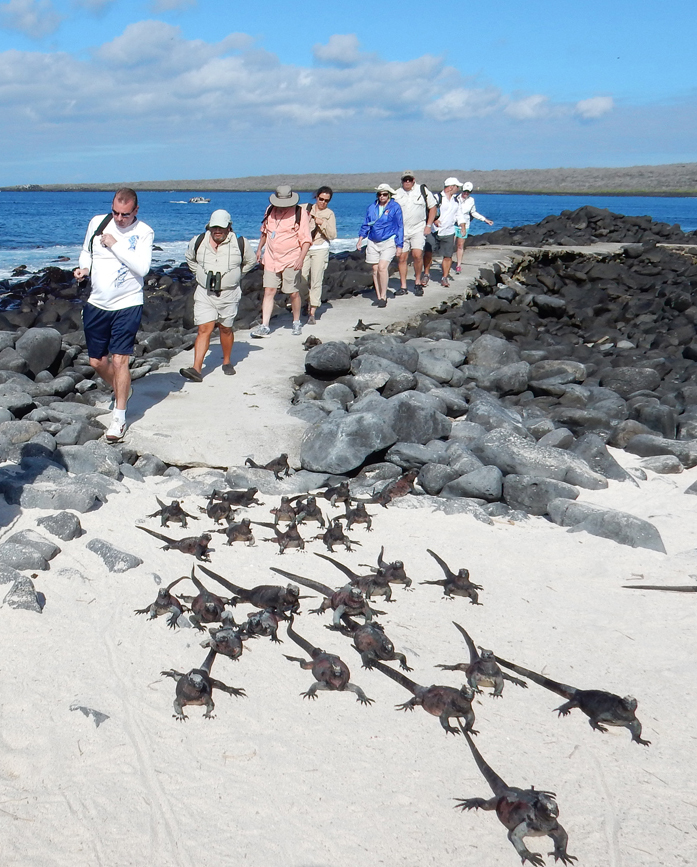
Marine iguanas seem to show the way as Silver Galapagos passengers head inland at Isla Espanola. * Photo: Charlie & Laurel Doherty
Our first excursion was on Isla Genovesa, the most remote island we called on and perhaps the most interesting. After a wet landing in Darwin Bay, we had an easy walk along a sandy beach and inland past some tidal pools. We were astounded by dozens of different birds we saw, such as red-footed boobies perching in bushes, Nazca boobies nesting on the ground, yellow-crowned night herons feeding in a pool, swallow-tailed gulls swooping past the cliffs, and great frigatebirds soaring overhead. It was impossible to give them a six-foot berth—the birds have no natural predators and no fear of (or, seemingly, interest in) humans. In fact, you had to be careful lest you back into a bird’s nest while framing a photo.
Returning to the beach, warm from our hike, we were glad we’d brought our snorkeling gear and wetsuits (fitted and assigned to us the night before). Though on the equator, the Galapagos Islands are not tropical, and the waters can be cool—thanks to the Humboldt Current that runs from Antarctica up the South American coast before veering west to the Galapagos (the current is likely also responsible for bringing such animals as penguins and fur seals this far north). The refreshing waters were a bit cloudy for fish viewing, but snorkelers were soon joined by a pair of frolicking Galapagos sea lions, to the delight of everyone.
Back onboard, we enjoyed our first of many lunches in The Grill, an aft space that seats about 50 for al fresco dining in the sunshine or under a canopy. There’s a full bar and a small buffet station for salads, some hot items, and tempting desserts including ice cream. Waiters serve a daily a la carte menu that always featured a delicious Neapolitan-style pizza, made-to-order sandwiches (such as hamburgers, hot dogs, salmon), and two more choices, one usually seafood (often lobster or crab). In the evening, The Grill dresses up a bit into Silversea’s signature restaurant serving (at no extra charge) steaks and seafood that guests themselves grill on hot lava rocks placed on their tables; dinner reservations are requested but so readily available that passengers could dine here several times if they so desired.
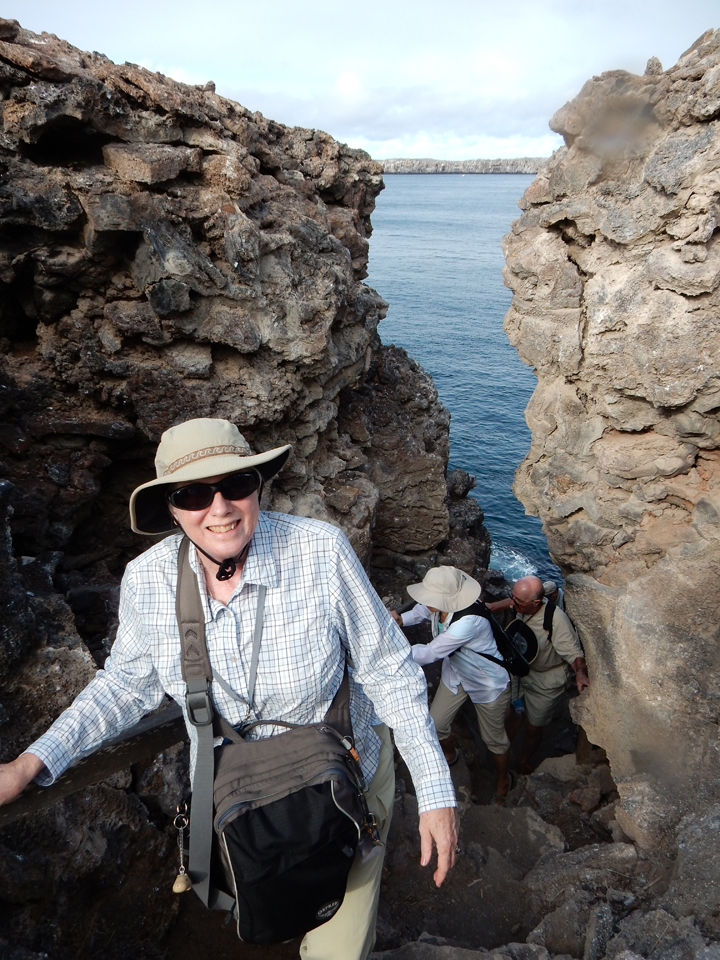
Silver Galapagos passengers climb Prince Philip Steps, a natural rock staircase, on Isla Genovesa. * Photo: Charlie & Laurel Doherty
Our afternoon excursion began with a dry landing at a dock followed by a steep climb up the Prince Philip Steps (a natural rock staircase augmented with some manmade railings) to a plateau. We trekked through a forest of gnarly trees, home to huge nesting colonies of Nazca and red-footed boobies, into an open area, searching for the elusive short-eared owl. Eureka—our sharp-eyed park guide fulfilled his promise to our guest guide to find one for her to photograph. But for many it was a struggle, even with binoculars, to spot the tiny brown and tan bird perched in a similarly colored crevice. No problem—a little farther along the trail the park guide found another short-eared owl, much closer to our path and very easy to see. Isla Genovesa well deserves it nickname, “Bird Island.”
The days flew by: a buffet breakfast in The Restaurant, then off on a morning excursion (or two); lunch back onboard, usually as the ship repositioned; then an afternoon excursion (or two). Our “North Central” itinerary called on a different island every day (sometimes two). In the evenings, we gathered for a recap of that day’s adventures and a briefing for the next day’s. Dinner, socializing, and then to bed, with wonders filling our heads.

Magnificient frigatebirds perched in bushes, Isla Seymour Norte, Galapagos Islands. * Photo: Charlie & Laurel Doherty
The wondrous highlights of our cruise were countless. On Isla Seymour Norte, it could have been Valentine’s Day as blue-footed boobies engaged in their awkward “sky-pointing” courtship dance while scores of magnificent frigatebirds hoped to attract mates by inflating their bright-red throat pouches to the size of a basketball. The golden-hued, three-foot-long Galapagos land iguana that blocked our path—the first we’d seen up-close—must’ve been a bachelor. On the rocky shore, swarms of marine iguanas (the only ocean-going type in the world) headed out to sea—presumably to feed, not breed.
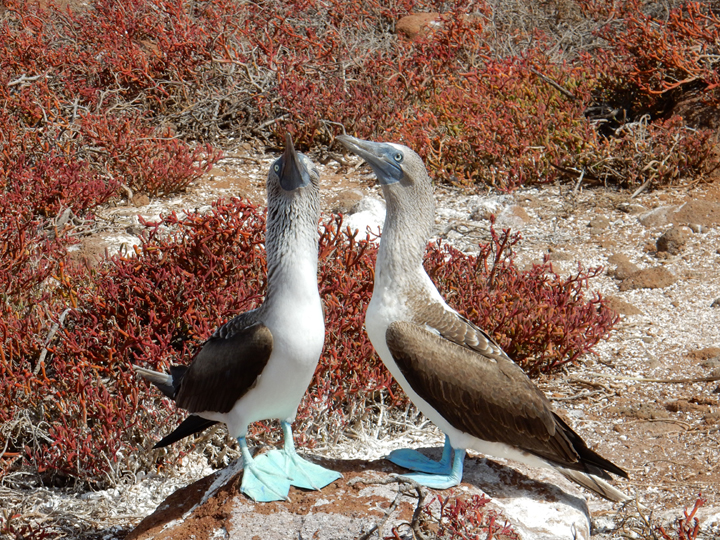
“Sky-pointing” courtship dance, blue-footed boobies, Isla Seymour Norte, Galapagos Islands. * Photo: Charlie & Laurel Doherty
In Isla Santa Cruz’s lush, green, highland forest, we came face-to-face with our first giant tortoises—dozens of them in the wild at the El Chato Reserve. Later we saw hundreds more—from hatchlings to 500-pounders—at the Galapaguera Cerro Colorado on Isla San Cristobal. Here the park rangers and scientists are helping to bring back the endangered species, as they are at the Fausto Llerena Breeding Center on Santa Cruz, where we observed more giant tortoise species—and rare Galapagos land iguana types, too.
Differentiating among species is most challenging—Darwin finches, for instance, have various types of beaks. But it’s easy to see some of the adaptations of the giant tortoises. Those living in the lush highlands on the large islands, like Santa Cruz, feed on ground vegetation and have shorter necks and legs and dome-shaped shells. Giant tortoises living on smaller islands in dry habitats have longer limbs and much longer necks, with saddleback shells whose edges are upturned behind the neck, allowing the tortoises to stretch higher to feed.
We encountered an extraordinary feeding frenzy when kayaking in a bay filled with green sea turtles. We heard—and felt—a resounding “thunk” on our bow, followed by a huge splash. We’d just been torpedoed by a longfin halfbeak during the fish’s frantic attempt to elude a ravenous sea lion. Galapagos waters are home to hundreds of types of colorful fish and other stunning sea life, easily seen while snorkeling—we even got up-close looks at a white-tipped reef shark and a manta ray.
Other indelible memories included: climbing hundreds of feet up a rocky, dry stream bed to a bluff for one of the most scenic views in the archipelago, which this day featured a pod of spinner dolphins flipping and flying across the waves (we later joined them in our Zodiacs); tiptoeing past giant waved albatross chicks in their nests then sitting on the edge of a cliff and watching their parents soar; and befriending locals in the sleepy village of Puerto Baquerizo Moreno and the more bustling town of Puerto Ayora—neither with any sign of a chain franchise.
Nor will we forget our guides—knowledgeable, patient, kind, generous, and amusing—who shared so much on tour and during presentations onboard. And sharing these wonderful adventures with our new friends from the Silver Galapagos made the experience even more special. On the final festive evening, after the captain’s farewell toast, bidding all adieu was bittersweet. We, like most passengers, were heading home in the morning. How we envied the fortunate few staying onboard for the “Western” itinerary to see the Galapagos penguin, the Galapagos flightless cormorant, and other treasures of the idyllic Galapagos Islands.
Know Before You Go
Itineraries/Fares: The Silver Galapagos sets sail every Saturday year-round from Baltra on weeklong roundtrips, alternating “North Central” and “Western” routes. The all-inclusive cruises are sold in a 10-day “Silver Galapagos Experience” package that includes roundtrip economy-class air between mainland Ecuador and the Galapagos Islands (Baltra); a two-night pre-cruise hotel stay with breakfasts at the Quito JW Marriott; an evening tour of the colonial city highlights in Quito, Ecuador’s historic capital; a post-cruise hotel day-room at the Hotel Oro Verde in Guayaquil (for guests with flights after 10 p.m.); Galapagos National Park and Ingala Transit Card fees; all transfers; and porterage fees. Brochure fares, per-person/double-occupancy, for the “Silver Galapagos Experience” package range from $6,750 to $10,950; early-booking, past-passenger, and other discounts are offered. Cruises may be combined and sometimes linked with Silver Explorer Central or South American itineraries. Land extension adventures to Machu Picchu or the Amazon are also available.
Weather: There are no extremes of heat or cold in the Galapagos Islands. Average daily low temperatures range from the upper 60s to low 70s, highs from the low to mid 80s. The islands are very dry, with only about four inches of rainfall annually, mainly from January through April, the slightly warmer months. Heavier rainfall is seen during these times in Guayaquil, on the coastal mainland, but temperatures here are similar. In the inland highlands, Quito sees a fair amount of rain during most of the year and is cooler; its average temperatures are steady year-round with lows in the upper 40s and highs in the upper 60s.
Money Matters: The U.S. dollar is the currency of Ecuador and the Galapagos Islands. Visitors are advised to bring new bills in small denominations for tips, taxis, and other small purchases. ATMs, widely available, dispense $20 bills. Major credit cards are accepted at many hotels, stores, and restaurants.
Medical Matters: No vaccinations are currently required for travel to Ecuador, but it’s best to check with your doctor well before departure to ensure your routine vaccinations are up to date. And you may consider adding hepatitis A and typhoid vaccines, possibly others, depending on your itinerary. Keep in mind that Quito is at an elevation of 9,350 feet, so if you are prone to or concerned about altitude sickness, discuss this and your options with your doctor.
Click here for more info on Silver Expeditions.


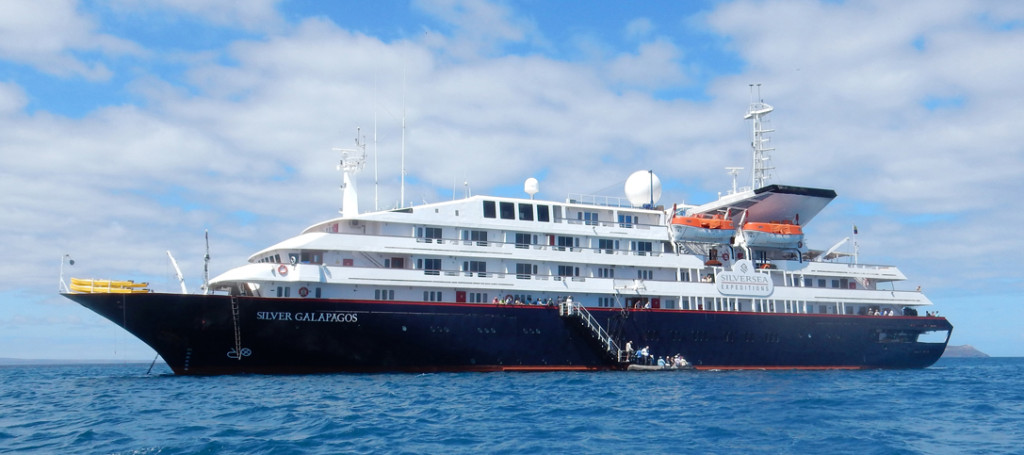
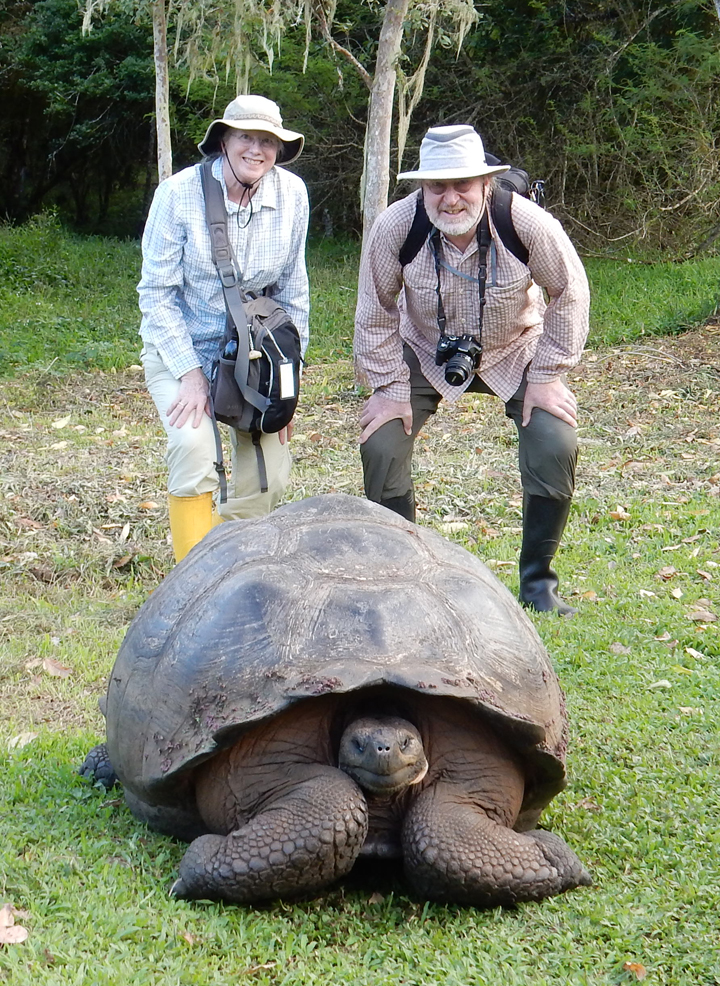

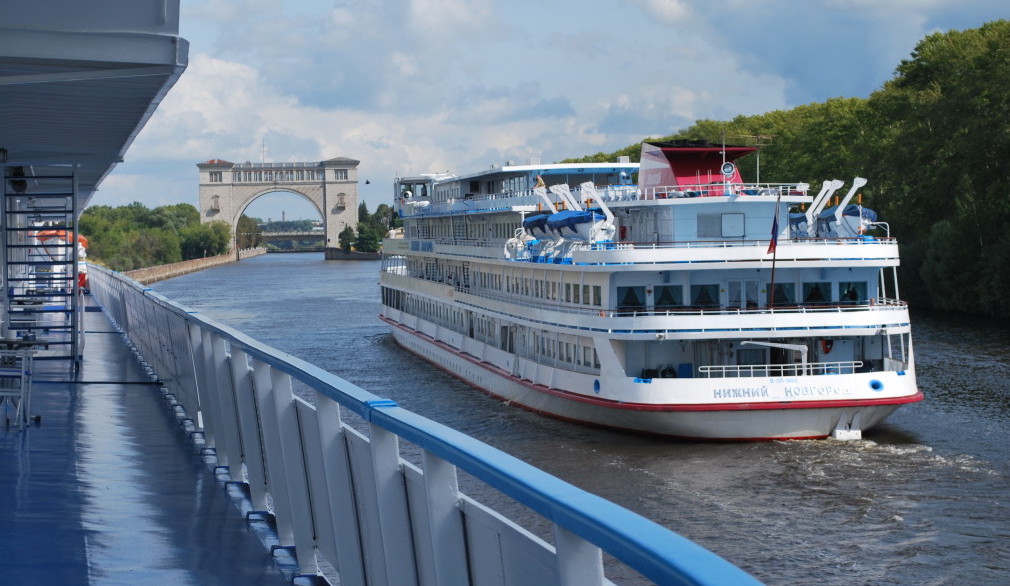

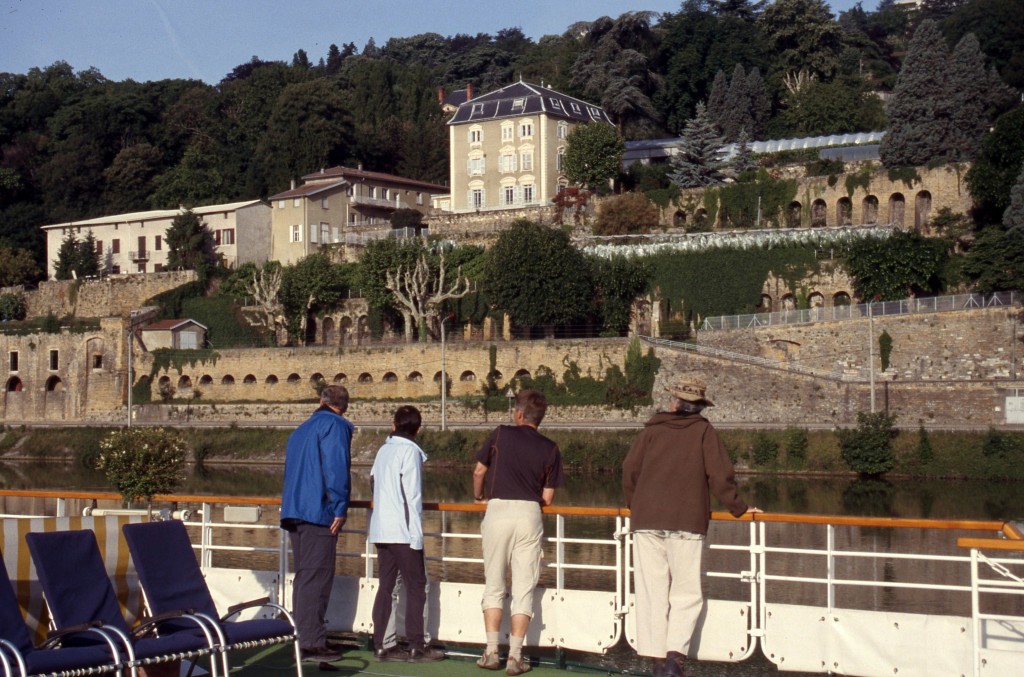
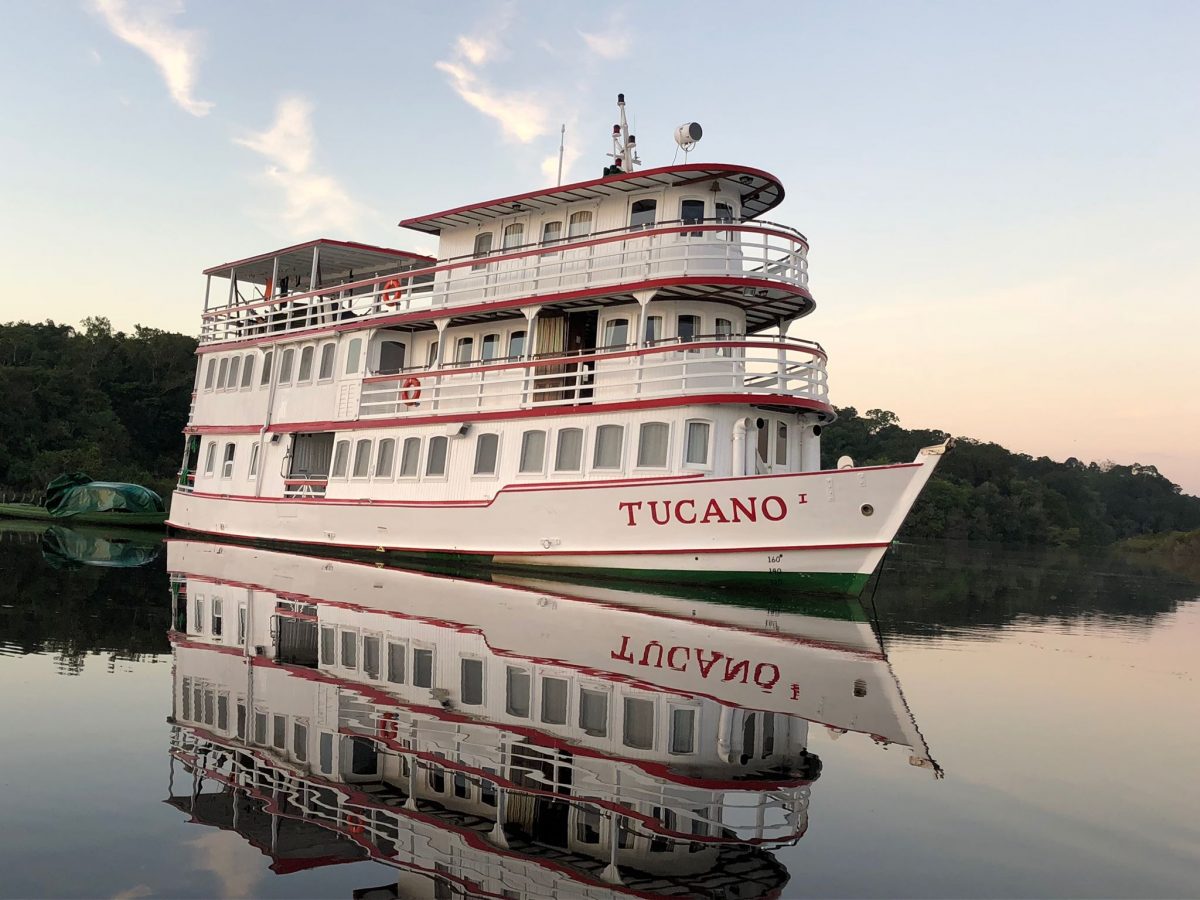





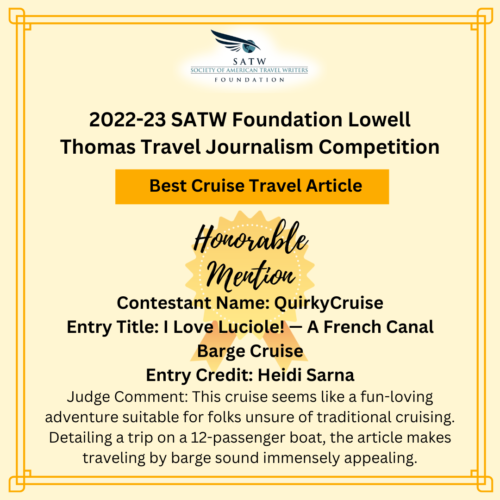
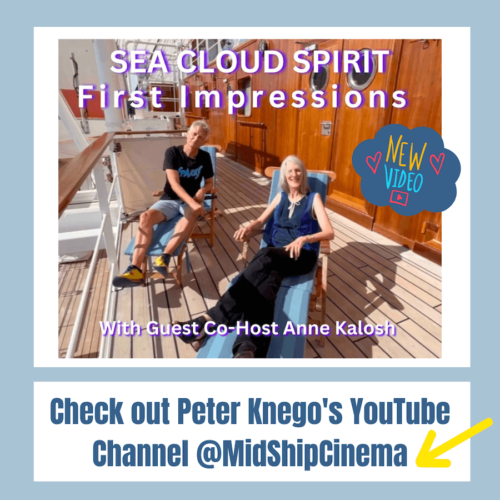


 HEIDI SARNA
HEIDI SARNA

